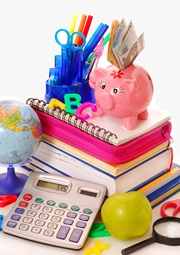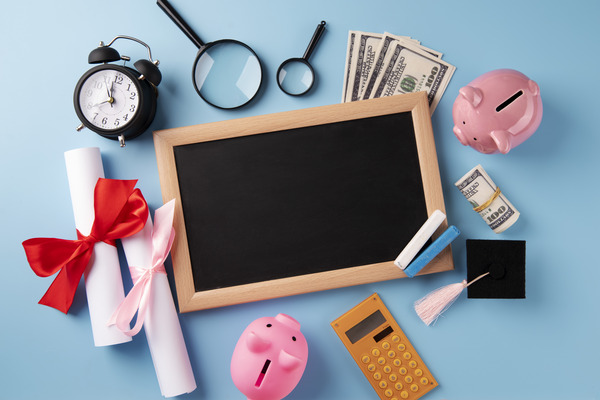Average Cost of Back-to-School Shopping
The National Retail Federation says a typical American household spent over $850 on back-to-school shopping last year, which is also the minimum amount to spend in 2024. Whether it’s a new pair of shoes, textbooks, writing materials, or state-of-the-art gadgets, back-to-school time refers directly to everyone’s pockets.
According to 1F Cash Advance research, parents will reevaluate their budget and may need additional financial help. This article will detail the average spending on back-to-school supplies and products in the forecast year.
We’ll analyze the money distribution process and its patterns and provide you with some recommendations, so you do not fail in budgeting. Let’s discover what factors are behind those costs and how to help you control these costs without giving up fresh starts or the delight of new supplies.
Breakdown of Average Costs
Back–to–school season is almost here, and now is the time to go shopping. Let’s look at the picture in 2024 and see where the money to support the average cost per student goes.
Average Cost Per Student
Per learner, back-to-school expenses now approach $700 in some states. We understand, and it’s a lot. But let’s look at the breakdown to know the real deal about the cash flow.
Breakdown by Categories
- Clothing and Accessories ($250): A new school year means new clothes, right? This ranges from the apparel they wear to the type of shoes and all the items children are attracted to. Fashion evolves much quicker than one can imagine, which is why it gets most of the attention when it comes to back-to-school spending.
- Electronics (around $200): Computers for notes, iPods for music, new laptops for typing papers, or even fancy calculators are necessities in today’s schools. With virtual learning and homework being the new way of learning, these gadgets are almost indispensable.
- School Supplies (roughly $150): Staplers, pencils, backpacks, and files – the essentials of every loyal student. This can range from what you would normally associate with school supplies to art supplies and those sleek planners that keep everything in order.
- Extracurricular Activities (about $100): The costs of clothes for a games group, musical devices, and other factors associated with extracurricular activities are likely to escalate—these range from registration fees to uniforms, shoes, and equipment for all the fun after-school activities.
Costs by Education Level
The costs may be significantly different depending on the age of the child and his studies, whether it is elementary or middle school, high school or college. Here’s how it breaks down with average costs:
- Elementary School – $500: At this level, most expenditures are on primary-need items such as school stationery and trousers/skirts. Electronics still needs to be considered a big player.
- Middle School – $600: It is a time when kids require more individual supplies and their first worthwhile electronics, such as tablets. Besides, they begin to be more conscious of the clothes they wear.
- High School – $800: This is where electronics, such as laptops and graphing calculators, get going. Sports, clubs, and cool outfits add more pressure.
- College – $1,200: College students are one of the best markets for buying everything from laptops to textbooks, which are incredibly overpriced, as well as dorm merchandise and clothing for internships and conferences.
Influencing Factors
After the fiscal cliff, which is the back-to-school season, parents and students should brace themselves for this new trend that appears to be annual. This year, various determinant factors are in play and account for how much everyone is willing to spend on notebooks, tech gadgets, and stylish accessories.
Economic Ups and Downs
During this period, there was a discussion concerning the rising inflation rates affecting back-to-school shopping. Back-class shopping is expected to reach record levels, and all of this is because of the economy. There is inflation in the prices of the simplest stationery used in school. Those pens and pencils may be tiny, but when the prices of notebooks, binders, and other requirements are summed up, the amount begins to look terrifying. When supply chain challenges are factored into the equation, the expenses incurred when moving merchandise or stocking groceries become more expensive, and this falls on our laps, the customers.
Tech and Digital Learning Tools
The final trend at the company level is the dramatic increase in tech requirements: Such a situation is far from when a calculator and some graph paper were enough. Now, schools are, to a greater extent, insisting on digital aids that can be used for learning. Desktop computers are starting to become the exception, while such devices as iPads, tablet PCs, laptops, and, in many cases, even certain software licenses are the rule. Therefore, the new tech-oriented transition implies that parents allocate their money for much more than conventional items. And let’s face it, even if you, for some reason, insist that your kid not use the latest tablet that their school may or may not be insisting on, there are other more persuasive forces out there known as peer pressure.
Fashion Trends
Clothing is typically a factor when children return to classes, especially when shopping for school wear. This year, the markets are shifting to conserving the environment, which is splendid but causes manufacturers to price their products highly. Furthermore, the usage of social media sites as a tool could be felt significantly. The famous social networks TikTok and Instagram have opened the curtain to the latest trends, so students are more concerned (and can express themselves) about being fashionable. This means parents often pay more to cater for items their kids can only do within the social setting.
Regional Differences
Finally, a factor that can greatly come into play regarding back-to-school costs is the place you reside in. This is a sign of a liberated market structure because regional factors influencing the economy will ensure that the prices of the same products will differ. For instance, the prices for products in the urban regions may be quite high because of the increased demand and cost of living compared to the rural regions where the number of firms may be limited, hence setting high prices for some products due to lack of adequate competition. Also, there are disparities in school requirements; some may demand more supplies or recommend particular tech accessories, cutting down on parents’ possible expenses.
Parental Strategies and Consumer Behavior
Blenders of back-to-school purchases can be a thrilling yet tiring exercise for parents. With summer closing, there is a mad scramble to acquire all that children will require when the new school season starts. Thus, to meet and maintain this annual spending spree, parents employ a set of techniques to stretch household incomes as much as possible but without compromising on children’s needs.
Some of the Usual Buying Behaviour and Techniques
The first step is to write a detailed shopping list, which, as a rule, is the first step for many parents. This assists in overcoming the problem of buying things on impulse and ensures that no necessity is missed. The average costs of school supplies vary by state and distributor. Some parents, moreover, divide the list into priorities: the parents buy primary supplies such as school uniforms, notebooks, and other necessary equipment first, while the non-sanctioned supplies are bought later.
Another common type of pressure is the desire to compare prices or offers with cheaper ones. Shopping for products is one task that parents do frequently, and they will ensure that they compare the prices across different stores or online websites in order to get the best bargain. This can best be done using bargain apps or simply by opening different retail websites and getting the best price.
Many consumers also stagger their shopping for weeks or even months. This method manages the funds and does not expose the organization to a huge amount to pay at once. Besides, with the help of this account, they can also use coupons and special offers as they appear.
Significance of Selling Occasions
Back-to-school season is a salvation for many parents, thanks to sales events. Some things help, for example, tax-free weekends. At the same time, these occasions of sales tax exemption on back-to-school items can result in huge savings, particularly for other costly items such as electronics or sporting equipment.
Online discounts and promotions are also very essential. Some stores have special Internet offers, and subscribing to a retailer’s email list may give you some incentives, from coupon codes to early bird alerts on sales. Besides, there are many added benefits when shopping online as it opens an avenue for parents to compare the prices of different products and even read customers’ feedback on the best promotions that should be conducted to ensure that a particular product is offered at the best price in the market.
Bottom Line
We have come to the end of our exploration of back-to-school expenditures, and once again, it is evident that this annual ritual certainly is no picnic when it comes to the family pocketbook. From pencils to laptops, we can list all the stationery known and used by students, and this list is only endless in the number of dents it makes on pocket money.
However, midst the hustle and bustle of it all, there’s a silver lining: a new year, fresh starts, new learning experiences, and the positive and bright looks everyone has when they return to school. Thus, as they say, the business is costly, but the children and future matter most. Here’s to another year of schooling, new experiences, and, perhaps, saving a little less in pennies.
Read how to help your child transition from kindergarten to school.





